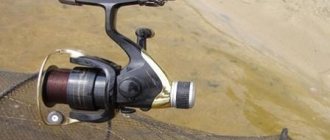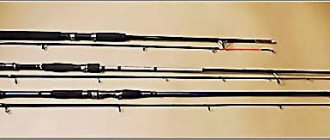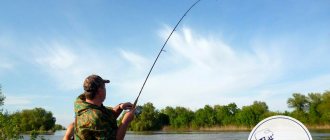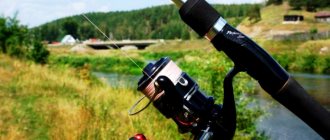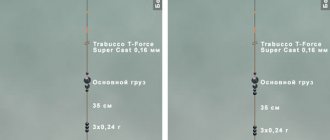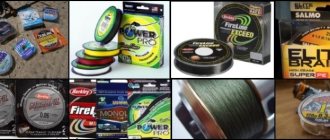I receive a very large number of questions about various aspects of spinning fishing, both to the editorial office of our newspaper, and in Internet conferences and by e-mail. Since many questions with minor variations are asked repeatedly, there is probably every reason to systematize them and from time to time organize a kind of “press conference” on the “Spinning School” page. Today I will try to answer the most frequently asked questions related to spinning rods.
Is the number of elbows in a spinning rod critical?
There are two extremes here. For some reason, some are sure that each connection negatively affects the working properties of the spinning rod, therefore, the fewer of these connections, the better it is. Others, on the contrary, believe that the number of knees has a minimal effect on the merits of a spinning rod.
Although in such cases it is customary to say that the truth lies somewhere in the middle, I am more inclined to share the position of supporters of multigenerationality. At least, as much as I have fished with 3-4-arm spinning rods, I could neither objectively nor subjectively find or feel any significant flaws in them. Therefore, I don’t see much point in the one-parters that are popular in America, even if they are 6-7 feet long. And spinning rods with a length of 11 feet or more are more justified in a three-leg version.
It is worth noting here that we are not currently comparing plug-in spinning rods with telescopic ones, since a comparison of all the most significant characteristics will not be in favor of the latter. Moreover, in my opinion, even a plug-in spinning rod of the “travel” type (with the number of legs from four or more) is still preferable to a “telescope” with the same number of sections, in all respects - both in strength and sensitivity.
How important is the correct placement of the guide rings relative to the “seam” of the spinning rod blank?
Until recently, few people were interested in this question. Moreover, most of us didn’t even know that there is a so-called “seam” on the spinning blank. However, the problem of the “seam” was touched upon several times in various media, and, as a result, now one should not be surprised when, before purchasing a spinning rod, it is checked for the correct installation of the rings - taking into account the line of the “seam”.
Interest in the “seam” is due to a phenomenon that is sometimes called “radial anisotropy”: the strength of the blank’s resistance to bending differs slightly depending on the direction of this bend. And if suddenly the guide rings are mounted haphazardly, this is said to threaten a lot of troubles - from deterioration in casting accuracy to a persistent tendency for the knees to rotate in the connection.
There was a period when I myself meticulously checked the position of the “seam” on spinning rods, but then it suddenly turned out that some of my spinning rods, which I have been successfully fishing with for many years, did not pass the “seam test”. Then it became even more clear that some companies, which produce, among others, high-end spinning rods, completely ignore this issue - and, it seems, deliberately. As it turned out, everything turned out to be much less dramatic, and if attention should be paid to the position of the “seam”, it was not in the first place. In addition, the blanks of some spinning rods are made using “seamless” technology, and in many others, the radial anisotropy is rather weakly expressed.
Arrangement of rings
The rings on the form must be located on the same line in order. In order to correctly position the elements, you must perform the following steps step by step:
- Traditional way.
- Use several parts to form a cone-shaped tunnel.
- The base is the leading component.
- The outermost part is considered as the top of the structure.
- New concept.
- The cone is shortened.
- The first element is shifted to the middle of the structure.
- Small parts allow the main line to pass through them.
Location Features:
- Linear arrangement.
- An average of 5-6 rings are used.
- The fewer the rings, the more the bait casting distance increases.
In order to check the reliability of the design, it is necessary to combine all elements at the same time. This will help you understand the correct fixation of the elements and detect any errors in the work.
Does the diameter of the guide rings greatly affect the casting distance with a “meat grinder”?
When we used monofilament fishing lines, especially hard and thick ones, the spinning rod’s range greatly depended on the size and geometry of the rings. Some friends and I once conducted a special experiment, comparing two spinning rods in action, which did not differ in anything except the rings. The difference in throw range reached fifteen meters. Therefore, at that time (fifteen to twenty years ago), many, including me, for fishing with a spinning reel, changed the standard rings to rings of increased diameter...
With the advent of soft braided fishing lines, the relevance of increasing the diameter of the rings has practically disappeared. Except that with a fresh (“untested”) FireLine there may be some problems due to its rigidity; for other cords, if there is a difference in range, it is practically not noticeable to the naked eye.
Types of ring arrangements on spinning rods without inertia
Let's consider the main types of arrangements based on the leader in the production of rings, the Japanese concern Fuji. Let us remember that this affects the throwing distance, the negative impact of excess mass on the blank itself, and bending strength.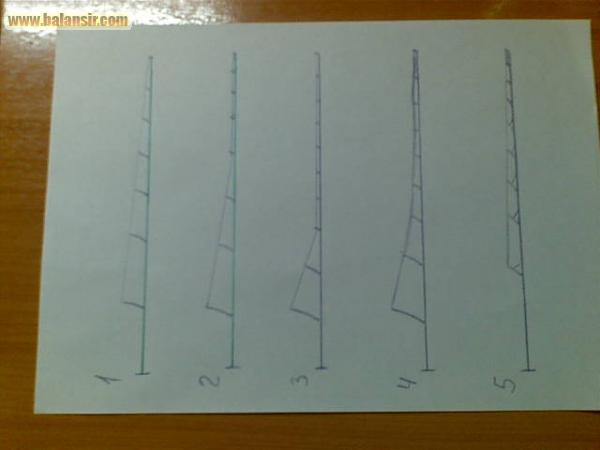
Straight cone. Fig.1. The simplest arrangement. Requires the least number of rings. Mainly used on spinning rods made of low graphite. Since more modular ones will simply break at a bend due to the small number of them. The sizes of the rings are large and despite the smaller number, their mass kills the dynamics of the blank. Most suitable for mono and coarse cords. The throwing range seems to have to increase, but the dead dynamics of the form reduce it. In terms of cost, due to the quantity and space, the frames are the cheapest. Plus probably only in winter. Fewer rings and a larger diameter means less ice. New Concept from Fuji. Fig. 2 Maximum unloading of the spinning rod tip is the main principle. Even despite the larger number of rings. The mass of the last all rings is often lower than one middle ring from the cone arrangement. The number of rings does not allow exceeding critical angles on the blank even from the most modular graphites. The most fashionable arrangement at the moment. The throwing distance when using PE cords is not affected. The frames of the input rings are higher, which ensures proper cord discharge. The cost is higher due to the quantity and more complex wound. Kirkman arrangement. Named after the famous American rodbuilder. The rings used are the same as in NK. They unload the form even more. And even more small rings. Looks a little wild live:-) There are fans in Russia. The placement according to the reviews allows you to make the most accurate throws and is least susceptible to clinging to any branches when moving along the banks of rivers. Despite such a miracle, the throwing range does not decrease. The principle of breaking the spring of the cord flying away from the meat works even better here than in NK. As Kirkman says, more friction on one ring is better than a little on all of them. Mainly used with thin PE and mono in UL. Untitled. Fig 4. The most popular arrangement among rodbuilders. Suitable for almost any type of cord and lines. And it probably absorbed all the advantages of previous arrangements. It is rightfully considered the longest-range. Rings are the same type as in NK. PE.Fig 5. Used mainly in marine spinning rods specifically for PE cords. The input ring is smaller than usual and stands further from the coil. Special frames of the rings practically eliminate overlaps of thin cords even on long spinning rods in strong winds. Shorter for the sea. :-). Rarely seen and have few fans. Many people change them to NK rings. Complaints about noise when casting even with fashionable expensive PEs and a decrease in casting range. Plus one - overlaps are reduced to nothing. The cost is significantly higher due to the tricky frames. Next time we'll look at the rings themselves... published
DEA
, for the site balansir.com
direct link to the article: Types of ring arrangements on a spinning rod under inertia-free
Is the “new concept” from Fuji as good as the advertising says?
About ten years ago I met a man while fishing who had a spinning rod in his hands with rather strange, by the standards of that time, rings. The ring closest to the reel was of medium diameter, the next one was noticeably smaller, and all the rest were very small, and even on very short legs. Although this was not in Japan, but on the Klyazma near Petushki, the system for selecting and arranging rings was almost no different from the now universally known “New Concept” from Fuji.
To my natural question, the man replied that his rings weren’t worth it out of hand. He and his son experimented for a long time and came to the conclusion that by narrowing the amplitude of the scattering of the fishing line with the first two rings, some advantages could be achieved. I don’t remember which ones exactly, because initially I didn’t believe in the idea itself and didn’t listen to explanations. But people could then patent this very idea and, at least theoretically, get rich...
As for my current attitude towards New Concept, it is not entirely clear. If we take long-range as the main advantage of a spinning rod, then the “New Concept” does not provide real advantages over traditional rings. I didn’t strictly check it myself, but I know that such comparisons were made, and the result was either equal, or the spinning rod was thrown a little further with the old rings.
Another disadvantage of the “New Concept” is that it is less suitable for fishing in the cold. And the main thing here is not even that the small rings are more likely to become clogged with ice, but that the cord sometimes freezes to the form - since the legs on the upper rings are actually absent.
Now about the positives. The main one is unloading the form. The absence of parasitic weight in the upper part of the spinning rod definitely has a positive effect on its sensitivity and, in general, makes it possible to achieve the kind of action that was previously considered unattainable with a fundamentally the same form. Spinning rods with New Concept rings are more balanced and more comfortable to fish with. It behaves better when playing, since it experiences a lower twisting moment under heavy loads. So the “New Concept” is more of a plus than a minus.
Balancing the rod
Check the balancing of the rod together with the reel corresponding to its power class by grasping the spinning rod handle at the place of its attachment, so that the base of its body is between the fingers.
Then, without shifting the rod, we transfer the center of gravity of the spinning rod to the bent index finger, thereby dividing the rod into two shoulders (the near shoulder is the handle with the reel, the far shoulder is the rod blank with guide rings).
In a properly balanced rod, the center of gravity - the place where the shoulders are balanced - should be above the finger, behind the reel seat, in a place located above the line guide of the reel, or in the worst case, in the grip area of the handle.
Fishing with an unbalanced rod is an extremely tiring task. If the rod blank is overweight, you will have to make the handle heavier, adding unwanted, additional weight to the spinning rod; otherwise, if the handle is overweight, it will have to be lightened by selecting a reel of less weight, which is not always acceptable. For this reason, when purchasing a spinning rod, to prevent inconvenience and unnecessary hassle, you need to check its balancing. Happy fishing! No tail, no scales!
Joke:
- Tell me, did you catch anything?
_The stranger asks the fisherman.
- Yes, I caught one perch and released it into the river...
- He was probably very small?
- Yes, as tall as you and just as annoying...
Fuji rings - is there really no alternative to them?
In fact, for many spinning players, other rings do not seem to exist. And, probably, there is a great rational grain in this. You can, for example, remember the Pacific Bay rings or some others, but Fuji is still considered by most of us to be a higher class. And the point here is not only in the promotion of the brand.
At the same time, I perfectly understand that for many of our readers it is more important to know not what makes Fuji rings good, but whether any other rings can serve as an acceptable replacement for them? We are talking here about economy class rings, which are equipped with relatively inexpensive spinning rods.
I could refer to my own experience, but it is still not entirely indicative. In my practice, there have been no cases when rings (not Fuji) based on aluminum oxide and SiC were rubbed with braided cords, although I have fished and fish very actively with many spinning rods with such rings, but my friends have had such cases, and this is symptomatic.
Having summarized this kind of information, I am inclined to conclude that among the rings of unnamed origin sometimes substandard items slip through. Moreover, for example, five spinning rods of the same series with rings do not have the slightest problem, while the sixth suddenly develops grooves on the “tulip” or, what is even more significant, the “tulip” remains smooth, but on one of them subsequent rings show obvious signs of wear.
Thus, the main advantage of Fuji rings, in my opinion, is the positive predictability of their properties, and not in these properties themselves. Well, Fuji rings on spinning rods from the middle price class and above are justified. This is approximately 130-140 dollars and so on.
Bait type
The more compact the bait, the further it can be cast. In almost all situations, three types are enough for me:
1. “Rain” is an excellent long-range bait. I prefer to knit it from silver haberdashery lurex on streamer double hooks or tees. This material is practically not subject to freezing even in severe frost.
2. “Polyurethane foam” - absolutely frost-resistant, can be painted in any color with permanent markers (although unpainted markers also work well). As a rule, I use baits no longer than 40-50 mm - this has practically no effect on the size of the trophies, but it has a very positive effect on the casting distance.

3. Silicone. To increase casting distance, it is better to use two-inch baits on streamer or regular double hooks. When choosing baits, I recommend paying attention to their strength and elasticity. I do not advise you to buy baits made in the Far East from unknown companies, even if the price is tempting. In addition to the fact that their mechanical strength is low (and changing a twister torn to shreds in the cold after the first bite is not much pleasure), several times I came across baits that at a temperature of about 10-12 C “dubel”, and this is completely unacceptable for fishing . Most often I use Power Grub from Berkley or twisters from Mann's - they suit me quite well both in terms of quality and price.
I would like to buy an inexpensive, but highly sensitive spinning rod, is this realistic?
One of the most frequently asked questions. I’ll note right away that sensitivity, determined primarily by the modularity of the blank, is fully achieved only in expensive spinning rods - like Daiwa Sima or St. Croix Avid, for example. When they try to “squeeze out” the module in cheap Chinese spinning rods, outwardly such spinning rods look nice and, as they say, fit in the hand. But as soon as it comes to fishing, they die like flies...
There is nothing surprising here, since the fragility and vulnerability of “coal” increases with the growth of its elastic modulus, and not all manufacturers are able to effectively deal with this unpleasant pattern. In the cheap category, this problem remains insoluble.
In the intermediate category, options are possible, but here a lot depends on luck. So, for example, in the Jaxon Extreme series, a spinning rod with a test of 10-40 g turned out to be simply excellent - both “ringing” and not breaking. But the test up to 30 g - alas...
Finally, sensitivity can be understood in a significantly different way - not by “playing it back” into the hand, but by the visual perception of the tip. In this simplified case, there is little point in chasing expensive spinning rods. Spinning rods with a monolithic tip that are quite good for their price can be found at the same “Jackson” or “Mikado”.
RINGS
B.M. “Is this SIC?” A very common question. I have no idea who this SiC is (editor's note: SiC is the material of the ceramic insert in the ring - silicon carbide). So far, not a single spinning rod that I have used has suffered from low-quality guides. And the rings on spinning rods costing more than 1000 rubles cannot be wiped with braid (cord). Having sold more than 1000 pieces in a couple of years, I have not received a single complaint about the frayed ring. Many gurus say that branded rings have some kind of special polishing that allows them to cast the bait further. I don't know, I didn't notice. In any case, for a fisherman with less than five years of experience, this issue is not fundamental. What is important for me in rings is that they are light, that is, both the “frame” and the “insert” are not particularly thick and bulky. The lighter they are, the more sensitive and balanced the tackle becomes. You can often see a spinning rod with a dough of 5 - 15 grams, but with rings on three “legs” and in a thick iron frame. Where is this good? That's right - to the trash heap. The number of rings is also important. If the spinning rod is expensive, i.e. If there are more than a couple of hundred green ones in the store, then you shouldn’t pay attention to their quantity at all - everything is done “as it should” there. But if this miracle costs a couple of thousand rubles, then too many of them will overload the form, and a small number will lead to breakdown.
S.O. The quality of the rings is a frequently asked question when choosing a spinning rod. Fundamentally, they perform one important function - they evenly distribute the load from the fishing line along the rod blank. It is also important that they are not sawed through with braided fishing line. Fortunately, it is now quite difficult to find rings sawn through braid. Any more or less decent fishing rod is equipped with aluminum oxide rings, which do an excellent job with braid. More expensive rods are equipped with “SiC”, but, by and large, there is no difference. The main thing is that when choosing a fishing rod, pay attention to the fact that when passing through the rings under load, the line does not give too sharp an angle, that is, everything should be smooth.
Now many manufacturers equip their fishing rods with lightweight guides coated with titanium nitride, which differ from conventional ones in smaller size and weight. If you come across such a rod, don’t be afraid, these rings also “hold” the braid perfectly.
M.F. Both the casting distance and the landing of fish partly depend on the rings. How many should there be on a rod? Each manufacturer has its own designs and installation methods. How they are placed on the rod, and in what exact places is too broad a topic. Moreover, every manufacturer pulls the blanket over themselves and says that theirs is better. We need to see if the rings are attached well to the rod, if the thread is wound evenly, if there are any extra protruding drops of varnish. And most importantly, check that there are no cracks, nicks or similar surprises on the rings. Any crack, even a small one, can cut your fishing line or braid in a matter of seconds. By the way, I would like to note that when using braids, the rings can become deformed, although this only happens on outdated models. Now even the cheapest spinning rods have quite acceptable rings. If the rings are made by FUJI (the name is engraved on the leg of the ring), then you can safely buy a fishing rod, that’s for sure, and the rings will definitely not let you down.
What type of spinning rod system should be considered the most universal?
This question is usually asked in cases where the goal is to choose one spinning rod for all or at least most fishing options. The craze that has taken place in recent years is now emphasized by the “fast” system - not that it has gone out of fashion, but for many the advantages of a more universal system are becoming more and more obvious. In some versions this system is called “regular”, in others – “moderate-fast”, in others – the formal designation may differ, but this does not change the essence. Spinning rods with this action make it possible to painlessly change from one bait to another (from a jig to a wobbler, for example); they are quite long-range and sensitive. Of the most popular spinning rods of this type, it is enough to name St.Croix Wild River or Daiwa Silver Creek-S with a dough of up to 21 g.
How to repair a broken spinning rod
In order to repair a spinning rod with your own hands, you first need to prepare the tools and materials:
- sharp painting knife;
- gas-burner;
- lighter;
- pliers;
- small file;
- sandpaper size 1000;
- alloy blade;
- pieces of carbon fiber rods of different lengths and diameters for repairing a spinning rod knee that is warped or broken;
- adhesives - waterproof PVA, epoxy, “Super glue” gel, for fixing bandages, guide rings, and repairing handles;
- waterproof clear varnish;
- nylon thread for fastening the installed access rings to the form, masking the place where the spinning rod broke;
- set of pass rings;
- corks from wine or champagne bottles.
Having prepared everything you need, you can repair both the failed outer pass ring and the broken form near the butt.
Form repair
In modern two-piece plug spinning rods made of high-modulus graphite, the following types of breakdowns occur:
- cracks or breaks of the first (butt) leg of the spinning rod;
- cracking or breaking of the upper leg.
Repairing the form in both options does not require significant expenses. It consists of the following steps:
- We inspect the rod at the point of breakage ( toponym in Russia
) for longitudinal cracks. If they exist, the knee cannot be repaired - under overload, the crack will inevitably increase in length and lead to complete failure of the entire knee. - If no cracks are found, use an alloy cloth to trim the edges of the warped elbow.
- From old, but not split graphite knees from another broken fishing rod, we select and cut out a piece 10-15 cm long, which fits tightly inside the parts of the broken knee - scupper.
- If necessary, sand the piece a little with sandpaper and a small file.
- We insert the scupper into one of the parts of the knee being repaired, so that it fits tightly inside it by 7-8 cm. We generously lubricate the edge of the knee and the scupper inserted into it with epoxy glue. When repairing the butt knee, the scupper can be passed inside it by removing the plug located at the end of the handle after the spinning reel seat.
- We insert the second end of the spigot inside the other part of the broken knee in such a way that the gap between the two joined parts of the broken knee is minimal.
- We cover the joint with epoxy glue ( a substance and multicomponent compositions based on organic or inorganic substances that can connect (glue) various materials
). - We wind a narrow nylon thread over the connection, trying to match its color to the tone of the cover of the form ( a type of printing product presented in the form of a standard paper sheet of a certain format with permanent document information reproduced on it and the space allocated for it
). - We cover the nylon thread bandage with waterproof varnish.
- If one of the rings of the spinning rod is extremely close to the place of breakage, then to strengthen the blank and camouflage the bandage, we remove it and fasten it above the junction of the broken parts of the knee with nylon thread.
- If the breakdown affected the varnish of the spinning rod rings or destroyed the winding that attaches the ring to the blank, then it is easier to remove it and reinstall it.
As a result of such repairs, the fishing rod ( the main component of the fishing rod
) retains its strength, elasticity, slightly changes the structure, but at the same time allows you to avoid buying an expensive exclusive knee. For the money spent, for any ordinary spinning player, such repairs will cost a pitifully small amount
It is always necessary to take into account the need for restoration using the method outlined above - for example, in case of breakdown of telescopic spinning rods ( sports equipment for fishing with artificial and natural bait, as well as the method of fishing using a spinning rod
) made of fiberglass or composite, which have the smallest wall thickness, strength and elasticity, it is best to choose a new one to replace the warped knee (
joint, knee (lat. articulatio genus) - the joint connecting the femur, tibia and patella
). The repair will not return the form to its original strength, it will significantly make it heavier, and if a severe predator bites, the repaired knee will break at the site of the previous damage.
Repair (a set of measures to restore the operational or serviceable condition of an object and/or restore its resource)
Tip breakage is an extremely severe damage to a rod that affects its multi-functional performance.
When fishing with light jig baits for spinning rods, the tip is extremely important. Thanks to it, the angler makes long, clear casts of small twisters and vibrotails. It allows you to make the game of bait more attractive. In addition, the tip can indicate the weakest, hesitant bite before the angler feels it with his hand.
Repairing the tip of a spinning rod for a number of reasons differs from repairing similar damage to the butt or second knee. Its internal diameter is either extremely small (it is very difficult to find a suitable insert), or the tip is solid (does not have a cavity for a scupper repair connection). Any increase in the hardness of the tip will lead to a change in its sensitivity, increase the casting distance, and have a bad effect on the performance of the bait. When overloaded, the insert installed in the tip breaks the narrow walls from the inside and completely disables this part of the rod.
Therefore, in order to eliminate the given damage, you should resort to another, more piquant repair method:
- We inspect the broken parts for longitudinal cracks;
- If cracks are not found, we process parts of the top in places of breakage with a small needle file to a length of 15-20 mm from the edge. During processing, the varnish is removed and the thickness of the top wall is slightly reduced;
- We connect both parts with a spigot - a tube of thick paper, which we preparatory lubricate with quick-drying epoxy glue. When connecting parts of the top, you need to ensure that the guide rings are placed along the same axis;
- 20-25 mm below and above the joint we wrap the sides of electrical tape, which will prevent glue drips from forming during the upcoming installation of the bandage;
- To eliminate breakage of the tips, carbon fiber is used. Since it is extremely difficult to purchase it in a store, most often it is burned out of pieces of old high-modulus fishing rods. To burn out carbon fiber, take a piece of carbon fiber elbow 20-25 mm long and 10-12 mm in diameter. Holding the piece in pliers, hold it over the flame of a gas burner until the smoke stops coming out. Carefully unwind the tube with the burnt-out binding agents, dividing it into a strip of carbon fiber and a carbon mesh (backing);
- Lubricate the junction of the two parts of the broken tip with slow-drying epoxy glue diluted in a ratio of 10:1 with hardener;
- We wrap the backing over the glue, pressing it tightly to the joint;
- We wrap carbon fabric onto the substrate. We coat each turn of carbon fabric with epoxy glue;
- We forcefully wrap a layer of tape over the bandage;
- After the glue has hardened, use a sharp knife to remove the tape and the sides of the electrical tape;
- We sand the bandage under running water with a file, and then with small sandpaper;
- We cover the bandage with waterproof varnish.
With this method of repair, place ( Place - location, arrangement, location, condition, point, etc.
), where the tip of the spinning rod broke, almost imperceptibly, and the rod itself retains its strength, elasticity and other fundamental characteristics.
Is it possible to pull a fairly large fish out of the water by lifting it with a spinning rod on a fishing line?
If the breaking load of the fishing line you are using does not exceed the limit indicated on the spinning rod, then there should be no serious obstacles to such a technical action. The manufacturer seems to guarantee it. But even here you can find your pitfalls.
For example, the form says 6-10 lb., but you have a FireLine test cord of 10 lb. If this cord is “correct”, then, as is known, its actual strength turns out to be slightly higher than declared, sometimes one and a half times. So there may be trouble.
On those spinning rods where there is no information at all about the recommended fishing line strength, you have to use only common sense. In such situations, it is important not to make too sudden movements and avoid sharp angles between the fishing line and the spinning rod.
Changing a tulip in emergency conditions
Experienced fishermen understand that the most unpleasant things happen during the process. If a tulip breaks down while fishing and you don’t always want to go home or to the garage, it makes sense to carry out an emergency replacement of the tulip. To do this you will need a special repair kit consisting of:
- electrical tape;
- masking tape;
- knife;
- pliers;
- lighters;
- instant glue.
There is no point in using epoxy resin, since it takes a very long time to dry, and in extreme conditions you will not be able to do a “clean” job - there is sand, water, dust around. Silicone hotmelt adhesive is also not an option since you need electricity for it. Instant-drying ethyl acetate-based glue - “Second”, “Moment” and others - is ideal for you.
Electrical tape and masking mesh can serve as an excellent seal in case of play between the tulip and the spinning rod. Instead of varnish, you can use ethyl acetate glue; it hardens quickly and has the same properties as varnish when it dries.
It remains to perform the last operation in repairing our spinning rod: securely glue the new tulip onto the tip of the blank.
- We will need two-component epoxy glue. Mix the glue components. For this purpose, it is convenient to use a pharmaceutical blister from which tablets are squeezed out. You can stir the epoxy with a small stick, such as a toothpick.
- Apply glue to the tip of the form and put a tulip on it. In order for the epoxy composition to be evenly distributed over the entire inner surface of the tulip, you need to turn it around its axis several times.
- Now we briefly remove the tulip and again apply glue to the tip of the rod.
- We return our tulip to its place, turn it so that it is aligned with the other throughput rings of the spinning rod.
- The epoxy that was squeezed out after planting the tulip must be removed from the surface of the form.
Acetone is suitable for this purpose, but not all household members will be happy with the pungent smell of this substance, so it is better to use alcohol for degreasing.
After the epoxy glue has dried, the spinning rod can be used again. The epoxy dries in about a day.
I saw an unusual spinning rod with a hexagonal blank, is it just for fun, or does it have a purpose?
Such spinning rods are actually produced, and, of course, not for fun. I tried one of them at work and overall I was very pleased with it, except for one small point. All the hexagonal spinning rods that I have ever seen are single-piece. I spoke about my attitude towards them a little higher. For most of us, this is not an option.
At the same time, I know of an attempt to make a two-legged spinning rod out of such a spinning rod, but this is technically difficult, and such processing will require additional investments, and a spinning rod already costs a lot of money.
The meaning of the hexagonal cross-section profile is to give the form maximum strength. Inside it there are also reinforcing partitions, which are hardly possible in an ordinary round form. So if detachable hex spinning rods of acceptable length suddenly appear, this may be in demand among power fishing enthusiasts.
Does it make sense to use particularly long spinning rods?
To a first approximation, as the length of the spinning rod increases, which is quite logical, the casting range increases. This is the main reason for the interest in long spinning rods. Although there is no clear quantitative relationship here, usually increasing the length of the spinning rod by one foot adds about five meters to the casting distance. This is true for a length range of seven to eleven feet.
I believe that eleven feet (3.35 m) is a reasonable limit for a regular spinning rod. There are also spinning rods of the “surf” class, intended mainly for fishing on the sea coast, but this is a completely different topic.
With a length of over eleven feet, the spinning rod becomes unreasonably heavy, loses sensitivity, and there is no longer any need to talk about a mandatory increase in range. And in some cases (for example, for G.Loomis spinning rods), the already considerable price rises sharply.
K. Kuzmin
Coil
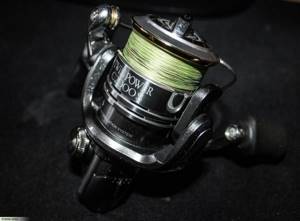
Typically, in winter spinning fishing, spinning reels are used. This does not mean at all that there is no chance for a “multi” in winter, it’s just that problems often arise associated with water getting into and freezing in the reel mechanism, freezing of the line faller window, and also with the fact that the hands of the multiplier body get very cold. However, if you are not afraid of some difficulties, you can successfully fish with a multiplier. As you know, world casting distance records were set precisely when using “mults”.
When choosing a spinning reel, you should pay attention to the width of the line-laying roller (the wider it is, the less it freezes) and the quality of laying the line on the spool (in my opinion, the so-called “honeycomb” option is best). In most cases, a Shimano reel size of 3000 is sufficient. I recommend choosing the weight for the rod so that it matches the balance, then your hand will get less tired when fishing. Not only elite-class reels meet all of these requirements. For example, I fish with Rioby Zauber 3000 and Tica Libra 3000 and am quite satisfied with their performance.
